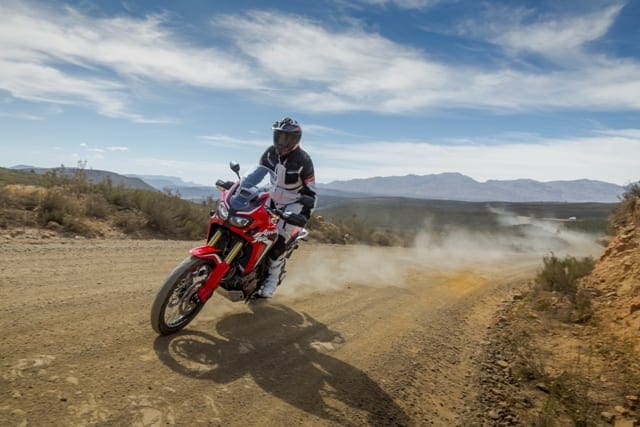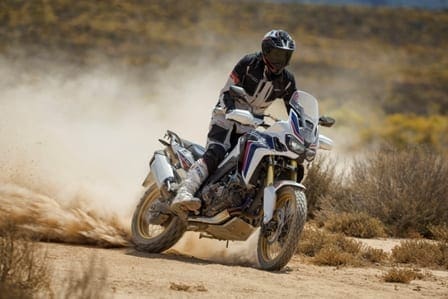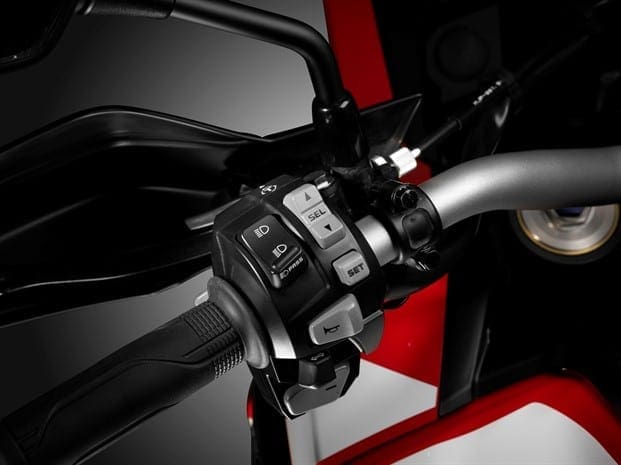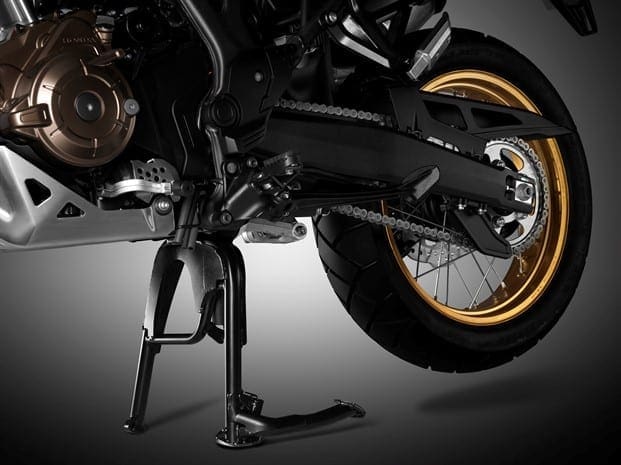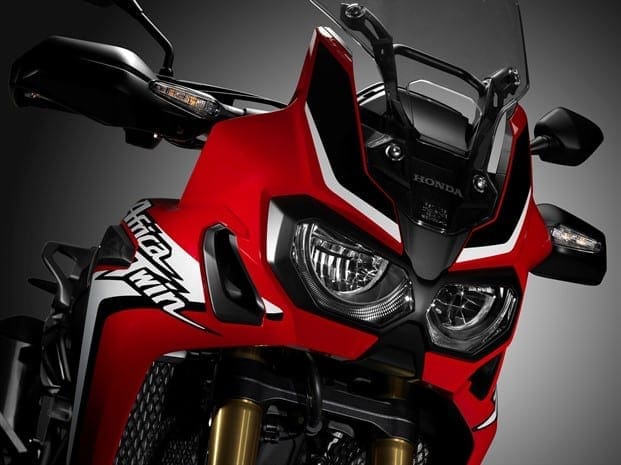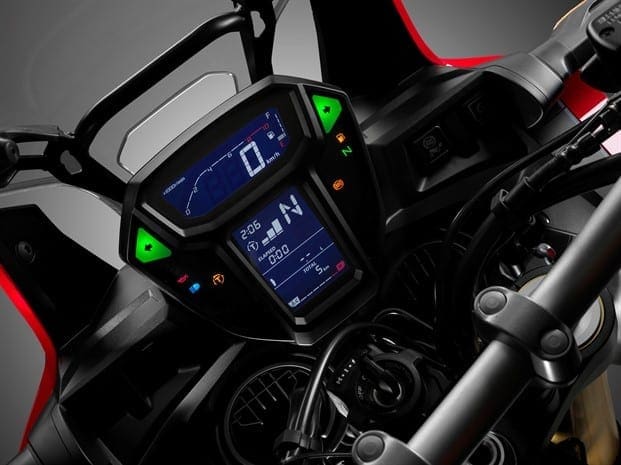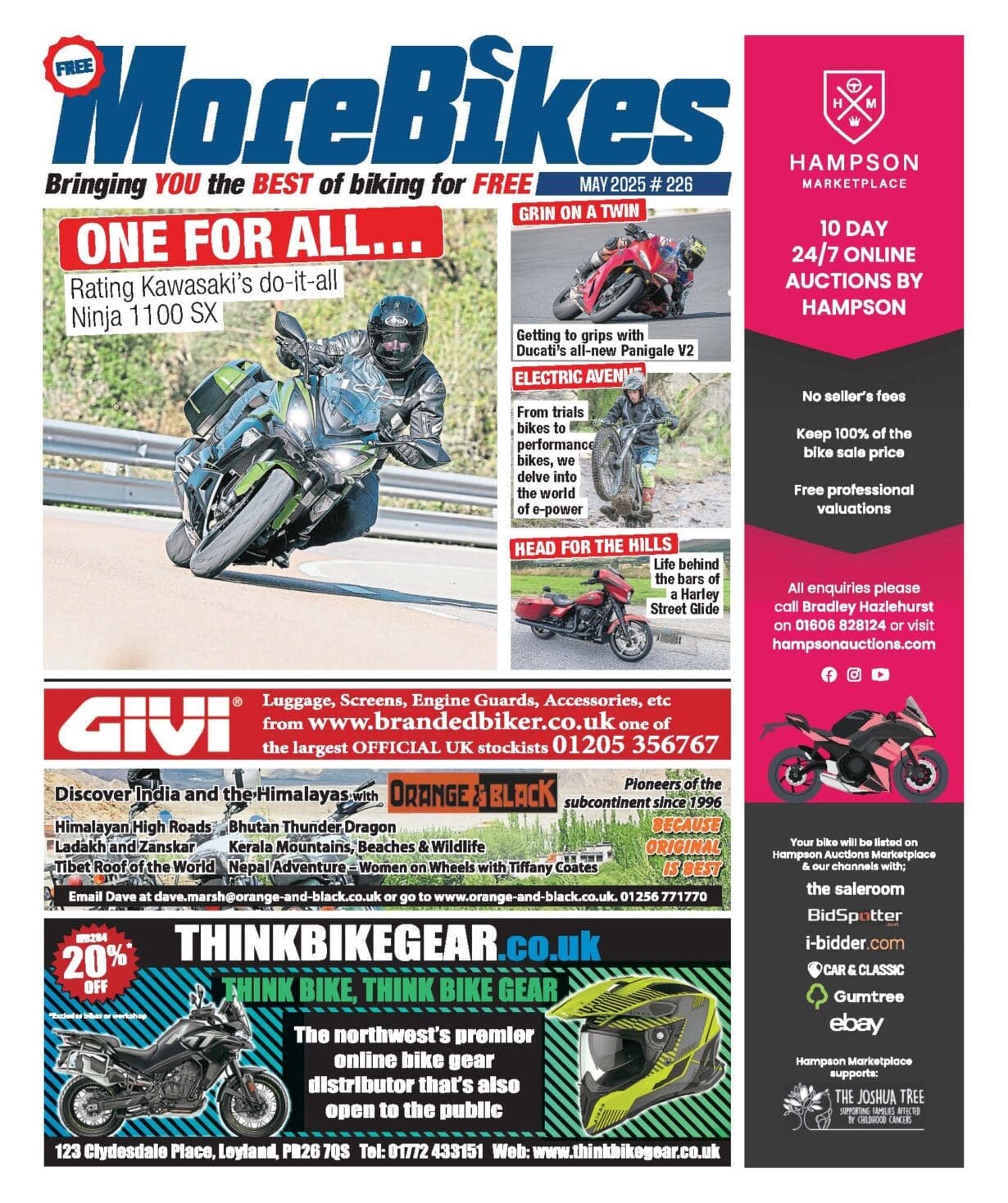World launch review – Honda’s 2016 Africa Twin.
Stepping back into the adventure bike sector, Honda’s reincarnated Africa Twin blends real-world competence with off-road pedigree.
A little history
It was just over a year ago that Honda unveiled its off-road capable True Adventure concept at the EICMA Show, in Milan. A motorcycle with a ‘Go Anywhere’ attitude, promising more than just utilitarian looks and dual-purpose tyres. Fast forward several months and the prototype morphed into a modern-day reincarnation of the Japanese brand’s iconic Africa Twin, picking up from where things left off in 2003 when the popular adventure machine got given the heave-ho.
Influenced heavily by the model of old, owing to its huge popularity, every single component on the new Africa Twin is unique, with perhaps the engine being the most notable change. The v-twin motor of the XRV750 has been dropped in favour of a lighter, punchier and more economical 998cc parallel-twin, which produces over a third more power – 94bhp as opposed to 61bhp – than the original.
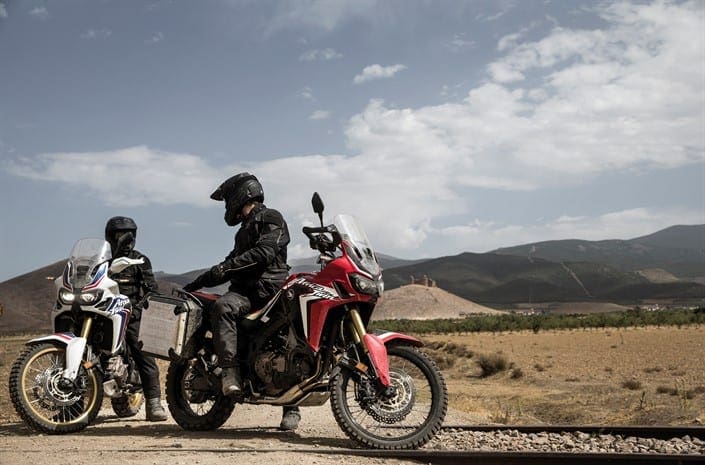
New tech and chassis
The motor itself is of revolutionary design, boasting many firsts for Honda including the innovative packaging of the water pump within the clutch casing, for compactness, and the crankcase contained oil tank, which lessoned the necessity for a deep sump; shortening the height of the engine and optimising ground clearance. It’s embraced within a perfectly tuned steel semi-cradle-type frame, mounted at six specific fixing points to achieve the right levels of flex for both on and off-road performance. The fitment of hi-spec, fully adjustable Showa suspension front and rear only exaggerates the manufacturer’s determination to achieve excellence, and then you’ve got an arsenal of electronics to get your head around. Honda has released two versions of the Africa Twin; manual and DCT. The former comes with four-levels of traction control and switchable rear ABS as standard, whilst the DCT model takes things to another level. As well as the tech already mentioned, the DCT can be selected across four different drive modes (D-mode, or three tiers of S-mode) and then you’ve got the addition of the ‘G’ button, which offers a more direct power delivery and added engine braking. In total, the DCT model can be toggled between 80 different setup configurations, each of which gets displayed clearly on the bike’s practical and stylish pure-digital dash. But of all the features and technology present, perhaps the most talked about and questioned feature is the 21” front wheel. Skinny and tall, it made perfect sense for off-road, but the question was whether it would compromise road riding? Having headed over to Cape Town, we were soon to find out.
First steps
There’s been a lot of hype surrounding the new Honda, but it wasn’t until I actually swung a leg over the bike that I started to indulge it. As had been portrayed, the Twin felt immediately very spacious with the wide bars and notably low seat height pairing up to offer a comfortable feel. Leg room was plentiful and my knee angle was relaxed at 90-degrees. It felt roomy like a tourer, only notably lighter and narrower than the brunt of such machines. Prior to our first day of riding, which would see us take on a 280km route on both trails and road, we had been told in the model’s presentation about the efforts put into mass centralising the Honda’s weight. It had been a core design focus, intended to provide a lighter and more stable feel. Having not turned a wheel, it wasn’t possible to confirm those goals had been met from a riding perspective, but I was impressed with how easy it felt to man-handle the motorcycle around, it lacking a top-heavy feel. Testing out the manual version first made it much easier to get my head around the tech. Lacking DCT or G-button options, I only had to worry about whether I wanted ABS on the rear and how much torque control I required. When you turn the ignition on, the Honda’s default setting is to provide you with level-three traction control – the most intrusive. The onus is on you to depress a switch on the left bar and work your way through the tiers, which are displayed clearly on the dash. Unaware at this stage of how sensitive the positions were, it was only when I set off out of the shale car park that I got some perspective. Within milliseconds of releasing the clutch and allowing the engine to drive me forward, the dash was lit up orange as the traction control kicked in and did its best to find me grip. The system, in its most aggressive state, was very engaging and completely overrode my requests for full gas with a wide-open throttle. The technology is governed by many different controls, but the best way to describe the interaction is along the lines of a misfire. The bike felt jerky and the engine note spluttered, occasionally clearing and launching forward before the rear wheel lost grip once more and repeated the process. It felt a very safe system, but was far too intrusive for me. A quick switch to level-two made the long trail up to the road slightly more bearable, but it wasn’t until I got into level-three that I truly felt comfortable with the aid engaged. Before I had chance to really play around with the last setting we had reached a Tarmac road, forcing me to put things on hold.
On the road
Aesthetically speaking, the Africa Twin is a neat and compact motorcycle. It has the suggestive features of an adventure-tourer, but it also bears similarity to a minimalist off-road bike. Its tank looks broad, but that’s only because the engine and frame are so skinny. It’s deceiving, as is the performance of the protective top fairing and screen. With a dead-straight 20-mile road ahead of us, the first stint on the Twin proved a great opportunity to gauge how well sheltered I was from the elements. My torso felt completely covered from the wind and it was only the top half of my helmet that was subjected to buffeting, which I considered perfectly acceptable. The top of the screen sat just under my eye-line, giving me a clear and easy view of the road ahead. Protection for my lower arms came compliments of the sizeable handguards and my legs felt well concealed behind the radiator encompassing tank shrouds. Doing motorway speeds and higher, it was evident that this bike had the potential to offer true comfort, aided massively by the enormous and well-padded saddle. I felt right at home on the Honda and didn’t find myself needing to shuffle around on the seat to find a stance that suited me, but the option was there had I of needed it to be. As the miles clocked by and I toggled away with the trip modes and consumption metres, by means of direction buttons on the left switch gear, it became blatantly obvious the one thing missing for ultimate comfort was cruise control. I was left with no option other than to man-up and hold the throttle open like you did in the good-old-days.
In the bends
Twenty minutes into the ride, the arrival of corners came as a real surprise. The Honda had shown its prowess in a straight line, but the question was how well it dealt with bends? Faced with a series of flowing bends, getting the Honda to turn proved effortless and I was impressed at how stable the bike felt at lean. We’re not used to seeing road bikes with such big wheels and I must admit to having been a little sceptical about the large wheel’s fitment, but during that first impression, it didn’t appear to compromise the bike in anyway whatsoever. It felt perfectly normal.
Now, the trail
As our route continued, we traded Tarmac for trail. The Africa Twin is fitted as standard with dual-purpose Dunlop Trailmax rubber. They’d proved good on road and I only hoped for the same inspiring feel on the dirt. Despite its clever packaging, the Honda is no featherweight; the standard bike weighing in at 232kg, whilst the DCT version bolts an extra 10kg onto that figure. Curious to see exactly what I was dealing with, I used the opportunity of a photoshoot to switch the torque control off completely and set off into a bend with my brain out and throttle open. It’s not hard to get a bike to slide out from underneath you, but it’s another thing trying to control one; especially one of this size. But there was no effort needed. I felt robbed of a scrap for control as the Twin’s rear-end moved out so controllably and elegantly under throttle, continuing to oblige me as I exhausted the offerings of second gear and went looking for third. There were no sketchy moments to recount and that immediately gave me a huge amount of confidence along the next 40kms of trail. I really tried hard to find the model’s weak spot, changing direction and gassing on simultaneously. All that would happen is the rear end would go walkies, before obligingly stepping back in line without any snatchy feel whatsoever. I’d like to say that I was impressed, but that would be an understatement. The loose surfaced trail also proved the perfect time to wind the pace up and see how the bike dealt with speed on the rough stuff. Even at speeds of triple figures I felt undeniably safe and was also amazed how effortlessly the bike dealt with big potholes that caught me out on occasion. Naturally, the bike always reacted during such moments, but it never felt unstable or scary. And moments after hitting an imperfection, everything was back under control. Talking the ride over with a load of other journalists during a coffee stop soon after, we’d all been astounded at the Honda’s ability. Even on road tyres, it had delivered on its promise.
The rough (er) stuff
The afternoon’s ride took us out over two of the most stunning, and bumpy, mountain passes I’d ever seen; Mitchel’s Pass and Bain’s Kloof. The first was fast and flowing, prompting sixth gear cornering during which the Twin really got put through its paces. As had been discovered during those very first corners, the bike remained unflappable regardless of the high speeds and it also proved fantastic at changing direction and holding a line. The second pass was very narrow, much slower, bumpier and far more technical. Rock-faced on one side with a sheer drop the other, it was the last place in the world you’d choose to go looking for trouble, but I was keen to see how the bike dealt with the extremely rough surface. Throughout the day, on road and trail, the suspension settings had remained the same and worked a treat. But riding the bike hard on this pass did highlight a problem with the front end, which seemed to rebound so quickly over the bumps that it began to slide a little, made worse by dips in the road which made you feel as if you were riding off the edge of the tyre. With a bit of time to tweak the setup, I don’t doubt the Honda could have been made far more suited to the challenge. But that also got me thinking about what it was I was asking the bike to do. It’s an adventure bike, not a sports bike, and yet it was being raced around as if I were at the TT. A pace I would never consider if I was travelling around the world with luggage and a pillion. I slowed things down and immediately found the bike was much more comfortable.
To DCT or not
The afternoon saw a switch of DCT and manual machines. Just like with the torque control option, the bike always reverts to neutral when it’s switched on and the rider has to engage D or S-mode in order to get drive. Unlike on previous DCT Honda’s, the Africa Twin’s system allows for two extra drive modes (S2 and S3). D-mode is for economical riding, whilst S-mode is more sporty. The higher the S-mode setting, the faster the downshifts get and the longer the bike will hold a gear; meaning you can rev it out. Riding back on the same epic route we’d come out on proved a great opportunity to go through all four options and assess their offerings. In essence, D-mode was really quite quick to short-shift and it made overtakes that bit more challenging – unless you paddled down the gears using the override gear selectors on the left hand switch gear. S1 was a slightly better proposition, S2 even more playful and instant, but it was S3 that got my vote. It felt most akin to riding a conventional motorcycle, not requiring any real fettling with the paddleshift system. That being said, when really put through its paces on the bumpy Bain’s Kloof pass, there were times when I felt obliged to downshift manually, as the system was a little too hesitant for my liking, in that context. What impressed me most about the DCT was how, regardless of the selected riding mode, you would hear the gear change but never feel it. Honda has got this technology nailed, especially so at a slower pace. That was always my hang-up with original DCT package, which could be a little indecisive and lumpy with switches between first and second gear. Those days are long gone, meaning you get to concentrate more on the road and less on your gear selection as you work your way through towns and villages. By the time we’d ridden back to base, I was immensely comfortable with the DCT Africa Twin. I thought I’d miss the clutch and struggle with practices such as U-turns, but that wasn’t the case. The pick-up was instant and meant one could really make the most of its 2.6metre turning circle, without fear of losing speed and toppling over; you just need to twist the sensitive and lightweight throttle and the power comes instantly.
Listen to Bruce talk about the DCT system:
https://soundcloud.com/morebikes/030-honda-africa-twin-launch-report
On pukka enduro rubber
The second day’s ride was all off-road. Our bikes had been kitted out with Continental TKC enduro tyres, but nothing else had changed. The idea was to ride the manual and DCT models around the same 16km dirt track, taking on steep and rocky climbs, deep sand, jumps and boulders. I kicked things off on the manual model and already felt confident, knowing full well how exceptionally the bike had performed on road tyres the day before. The challenge of the day was to grasp how differently the models performed around the circuit, to which I was pretty adamant I’d come back favouring the manual over the DCT version. Set off one at a time, I had my bike’s traction switched off and torque level on one. The big Honda felt quite the opposite, obligingly taking on any harsh surface that came its way and switching direction as if it weighed much less than it did. Deep sand is a nightmare on any bike and it was the thing I feared most for the Africa Twin. Not knowing the route, the first stint of sand really caught me out and I felt the front wheel start to fold. Rolling off the throttle only made things worse, but a hand full of throttle got everything back in line and the bike righted itself without too much concern. This is where the narrow front wheel really came into its own, navigating the deep sand and abundance of other obstacles that came my way. Before long I was quite literally flying on the bike, hitting random mounds of soil and turning them into jumps. The Honda had a tendency to nose dive, unless you really accelerated hard at obstacles, but even when it did land on its nose it wasn’t overly hard to get back in control. By the time I’d completed the circuit I was well and truly sold on the idea that this was a genuine off-road capable machine. The question was whether DCT could improve the experience? Forgetting to switch off the torque control, my first impression of DCT wasn’t all that great, but then I realised my error and turned everything off, with the drive mode selected to S3 and g-button activated. The first part of the trail was downhill and it was impressive to experience the severity of engine braking that came as part of the G-button function. It was as if I had a geared bike beneath me. Not having a clutch did feel weird, but the farther I went, the less I began to think about it. I also thought much less about my gear selection – as the DCT sorted the best option for me. Quite unlike the road experience, I never once considered changing the gears manually as the system was always sharp and punchy, allowing for instant throttle and big slides out of every corner. Before I knew what was happening, DCT was quickly becoming my favoured choice, simply because it freed up so much of my time and helped me to think purely about the ride and nothing else. There were no flaws to the system and I came back to the starting point convinced that if I had to choose, I’d go for DCT. Throughout the course of the launch, DCT had stood out as the premium option for touring and town work and it had now done the same on the dirt. The only area where it lost out a little was on the fast-paced mountain pass, where a manual transmission made more sense to me. Again, that’s not what this bike’s about, whereas the other areas define it.
To sum up
Transmission type aside, I was mostly taken aback by the competence of the Honda. It’d delivered on every front, from economy to comfort, handling to true off-road ability. There are plenty of motorcycles out there that suggest their competence in all these areas, but I can’t think of one that can match the Africa Twin in every regard. Honda’s done something magical here, it’s reborn a legend.
Specification: HONDA CRF1000L Africa Twin
Engine: 998cc, liquid-cooled, parallel twin with Unicam
Peak power: 94bhp (70kW) @ 7500rpm
Peak torque: 72 ft-lb (98Nm) @ 6000rpm
Transmission: 6-speed manual or DCT gearbox
Frame: Steel semi-double cradle-type
Final drive: Chain
Wheels – Spoked and tubed
Front: 90/90/21
Rear: 150/70/18
Tank capacity: 18.8 litres
Wheelbase: 1575mm
Seat height: 870/850mm
Kerb weight: 232kg ABS / 242kg DCT
Prices: £10499 ABS / £11,299 DCT
Contact: www.honda.co.uk

